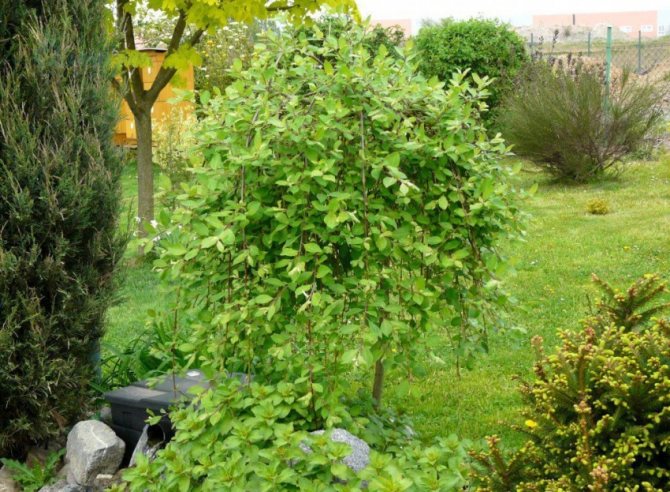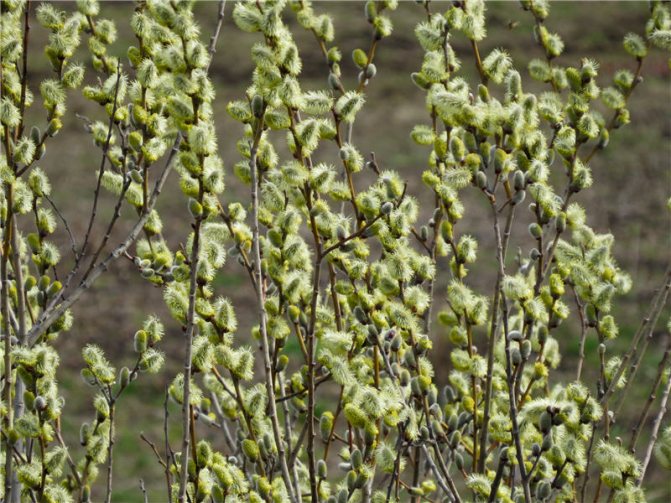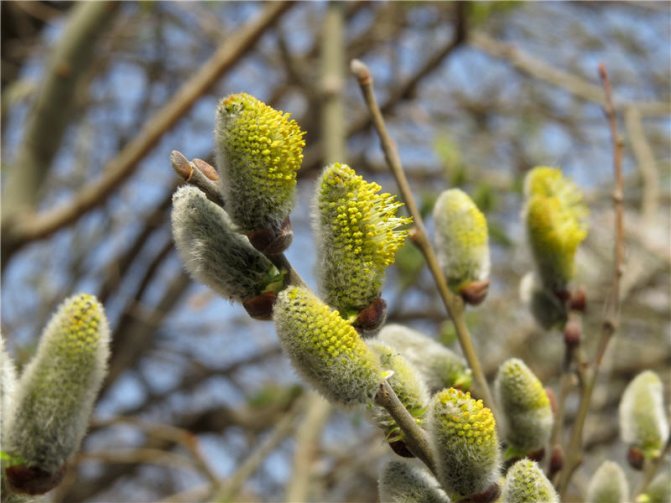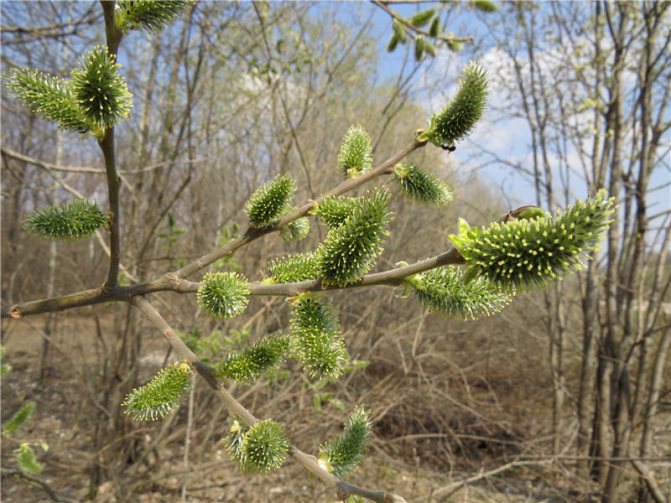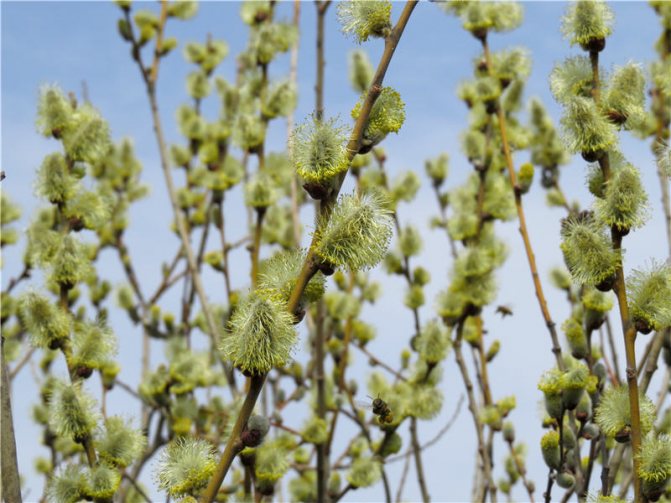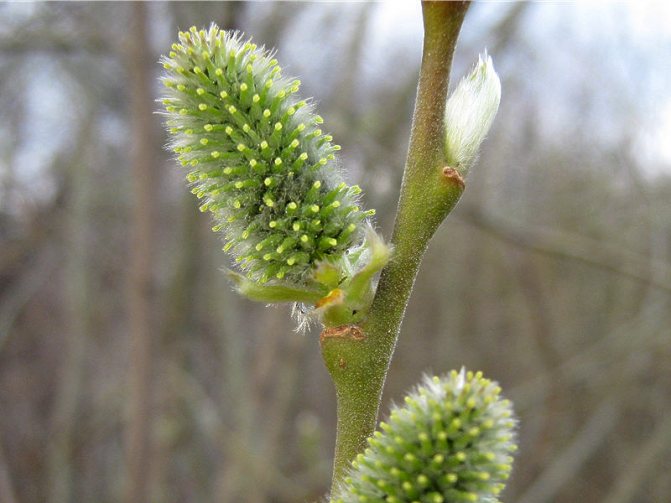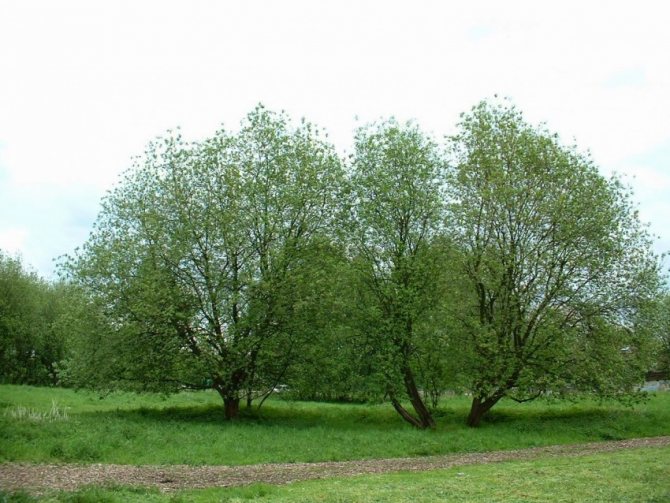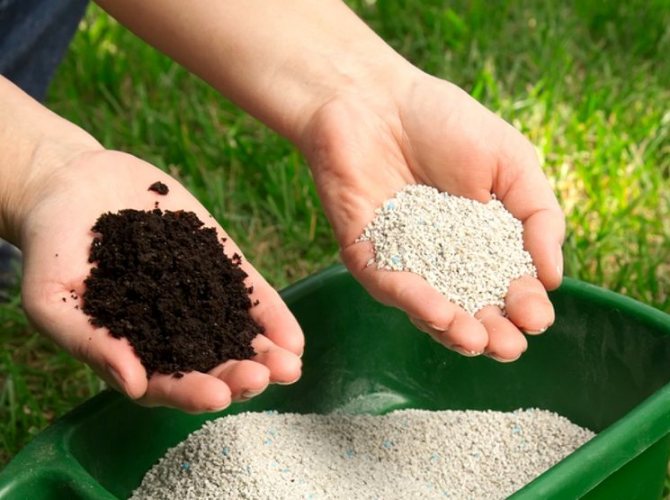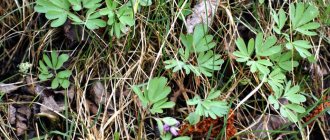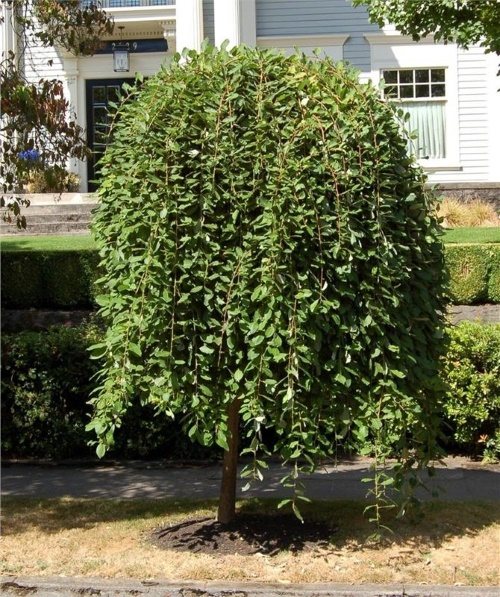
Perhaps, everyone at least once saw the majestic gorgeous willows on the banks of the river, bowing their long lashes to the water. Did you know that not all of them are impressive in size, especially in height? Thanks to the efforts of breeders and such cunning procedures as grafting and standard formation, the pendula willow appeared. This culture is the dream of any humble site owner. Having preserved its graceful weeping crown, the willow has turned into a compact tree and does not require much space. True, she will need more attention to maintain the density of the crown, especially in terms of pruning.
General characteristics of the shrub
The plant belongs to the willow family and is correctly called bredina. Among the people, the tree got its name because its foliage became the favorite food of goats and sheep... Another common name is rakita. Throughout the year, the tent-like weeping shrub looks very attractive: soft seals cover the shoots in spring, which then fill up with dense foliage and beautiful yellow flowers until autumn, while in winter, against the background of snow, even bare shoots from greenish-gray to red-brown attract attention.
The tree has an average size of 3 to 10 meters in height and a powerful, branched root system. Pendula's homeland is Europe, but it has taken root well in many other parts of the world, including Russia. The average life span is 30-40 years, but sometimes it reaches 150 years. The shoots are long, weaving, cascading down to the ground - this is what is of decorative value in goat willow.
Types of nonsense
Botanists classify the plant as a tree or arboreal shrub. Loves light, unpretentious to the choice of soil. For today the following varieties of goat willow are distinguished:
- Pendula - reaches about 3 m in height, is characterized by a wide weeping crown, dark green foliage, elliptical shape 8-10 cm. Looks great on a trunk. Life expectancy is short - up to 30 years. Loves abundant watering, takes root on any soil, especially well near water bodies. It fits perfectly into the landscape both alone and in a group. The coniferous neighborhood adorns the composition. In the care, pruning of shoots is important, only the correct formation of the bush in the first year of life will create the required exterior.
- Kilmarnock - a miniature tree, its height is only 1.5 m. Loves light, tolerates frost well, grows on any soil. Does not like excess moisture, watering should be moderate.
- Mac - has a spreading crown and reaches 10 m in height.
Deciduous deciduous woody with natural weeping crown
There are not many of them: we will get acquainted with the three most spectacular of them.
Hanging birch
It is she who is the symbol of Russia, wherever you see her, this tree will remind you of the Motherland.
Hanging birch, photo by the author
Hanging birch, warty, ordinary (Betula pendula, syn. B. verrucosa) - openwork tree up to 25 m high. At a young age, the branches grow upward, over time most of them become drooping.
Hanging birch 'Youngii' in Logo Park, Kamensk, photo by the author
Decorative form ‘Youngii’ up to 8 m high, domed crown.
Hanging birch 'Youngii' in a mixborder, photo by the author
The form is propagated by grafting on the stem of the original species.
Our market will help you to choose seedlings of birches and other ornamental trees by comparing the prices of different online stores. View a selection of weeping deciduous trees for summer cottages.
Willow of babylon
Luxurious tree. Harmoniously by the pond, on the lawn.
Willow of Babylon, photo by the author
Babylonian willow (Salix babylonica) - a spreading tree up to 12 m high and wide; because of its powerful roots, one should refrain from the temptation of planting it near buildings.
Lespedec Thunberg
A beautiful (especially in bloom) weeping shrub, which we have already met in the article Trees and shrubs near us: 9 beautiful representatives of the Legumes or Moths family.
Lespedetsa Thunberg with weeping shoots is especially effective in bloom, photo by the author
It has been noticed that with age, "crying" is acquired by individual specimens:
- catalps;
- common pear;
- apple trees of Nedzvetsky;
- silver maple;
- narrow-leaved sucker;
- bird cherry and others.
Reproduction and cultivation of a tree
Propagated by seeds, grafting and cuttings. Seeds must be used after 10 days after ripening, otherwise germination is lost. Flowering begins in April with golden catkins about 10 cm long, it lasts about 2 weeks. The fruit is formed in May. It has the shape of a box measuring 8 cm, which contains up to 20 seeds with fluffy growths.
It is easier to root a tree by cuttings. To do this, cut branches at least 10 cm long should be placed in a bucket for several days. Good drainage must be done in the hole, compost, place a stalk, bury and provide abundant watering.
The crown should be formed immediately by cutting off the lower branches, the growth bud should always be directed outward.
Not every gardener can graft on a stem. This is a rather complicated process that requires some knowledge and skill. Goat willow on a trunk does not take root in all varieties. For this, Pendula is best suited. You can also use your own trunk as a trunk. Subsequently you need to monitor the kidney very closelyso that it does not appear below the vaccination site. If this happens, then the kidney must be removed.
The best option would be to purchase a ready-made seedling in the nursery. When buying, you need to carefully check the tree so that it is healthy. The bark should be intact without cracks, there should be no dead scales.
Soil preparation and watering
Bredina is not pretentious to the soil, it will take root well in almost any conditions. But it will feel best on loamy soil, which is dense and retains moisture well. In the spring, for planting, you will need a hole 40 cm deep and 50 cm wide (so that the entire root system fits). At the bottom of the hole, you need to make good drainage, then fill 1/3 of the earth or better with such a mixture; in a 1: 1 ratio, combine compost, humus and peat, you can also add a little sand. For growth, feed with nitrogen fertilizer, then place the seedling in the center and bury it.
After watering abundantly, a young tree will need about 25 liters of water per week. To make the moisture evaporate less, it is recommended to make a layer of mulch near the trunk. To do this, you can use the following materials: sawdust, pebbles, expanded clay, peat, dried grass, paper. And also regular hilling will be required, which will oxygenate the plant and the soil will not crack.
Where is goat willow used
In addition to external beauty, the plant has found application in various areas of human life. So, its flowers are an excellent early honey plant, a hemostatic decoction, a medicine for colds, a regulator of perspiration, rheumatism and many other diseases are made from the bark. A decoction of the bark is great for stomatitis.... And from flexible branches, excellent baskets and other products are created.
Choosing an unusual plant for planting on their site, many overlook the well-known, unpretentious and winter-hardy willow growing everywhere and everywhere. We would like to draw your attention to the standard forms, which look incredibly decorative both in single and in group plantings.
Stamp willow in landscape design is quite popular: graceful trees are usually planted near reservoirs, in Japanese gardens and rock gardens. Willow on a trunk with long hanging branches goes well with dwarf and ground cover conifers, as well as various moisture-loving plants.
A standard willow with erect shoots, similar to a dandelion, is used to decorate mixborders, landscape compositions in a regular style, and in general it will look amazing alone against the background of a lawn, as well as surrounded by low-growing shrubs or perennials.
Caring for willow on a weeping stem is not difficult, since this plant is, in principle, considered unpretentious. However, in order to preserve its decorative effect and make the crown look like an umbrella, it is recommended to prune immediately after flowering. If the tree is still young, then usually shoots up to 15 centimeters long are left, cutting off at the bud, looking up or to the sides. In an adult standard willow, the shoots are cut to two-thirds of the length, which makes the crown more branchy. Erect-stemmed willows also need pruning to maintain a neat, dense crown, which can be either globular or mushroom-shaped. Actually, any shape that you like!
Popular varieties of willow on a trunk
Whole-leaved willow Pendula
(Pendula)
on the trunk has a weeping crown shape. The pinkish young leaves turn green rather quickly, and in the fall they acquire a pleasant orange-yellow tint. They have an oblong shape with a sharp tip and usually grow in length up to 15 centimeters. This willow variety is quite winter-hardy and wind-resistant, it tolerates sharp temperature changes well. It grows and develops best in a sunny location in sandy loam or peaty soil. The growth rate of shoots is small - about 20 centimeters per year, but this variety must also be sheared to thicken the crown and increase the decorative effect of the whole plant.
Iwa Hakuro-Nishiki
on the trunk it is quite vigorous with long, upward-growing shoots, so that, even with strong spring pruning, its dense and rather wide crown (up to three meters in diameter) will delight you all season. Young leaves of this willow also have a pinkish tint and then turn white-green. Hakuro-Nishiki looks very beneficial against the background of plants with a monochromatic dark color. To plant a willow of this variety, you also need to choose a sunny place, and add sand and peat to the planting hole if the soil is clay.
Purple willow Nana (Nana)
on the trunk it has thin erect shoots that sag closer to the tips under the weight of dense foliage. The densely growing light green leaves have a narrow oblong shape and grow up to fifteen centimeters in length. This species of willow got its name from the purple earrings that appear on the shoots even before they are covered with foliage. Nana is less tall than Hakuro-Nishiki and will be up to two meters in diameter. It should also be planted in a sunny area with moist and loose soil.
Highlights of grafting
What rules must be followed in order to grow a beautiful standard tree, pleasing to the eye and harmoniously fitting into the design? Here's a quick step-by-step guide:
- Grow the base (or stem). A young seedling is tied to a support and allowed to develop to a certain height.
- Take a healthy stalk with two to four living buds.
- Above the upper bud of the cutting (scion), make an oblique cut, and in the lower part, using two slices, create a kind of wedge.
- With a pointed section (wedge), carefully insert the scion into the stem so as not to damage the latter.
- Treat the junction with a garden pitch and tie it with a plastic band or electrical tape, which over time can be changed to new ones, and after a year it can be completely removed.
- After a month, the stalk should take root, and new buds will appear on it. Freshly baked shoots will soon form, and as soon as they grow twenty centimeters, they will need to be pinched correctly.
Vaccinations should be manipulated in the spring, in dry, sunny weather, so as not to bring bacteria, fungi or infection into the junction.
It is recommended to regularly feed the grafted trees with nitrogen fertilizers (preferably twice a summer), and also treat them against diseases and pests for preventive purposes.
What to do if the grafted shoot has not taken root? It's okay, it will be possible to try again soon, but it is recommended to do this a year after the unsuccessful vaccination.
Recently, gardeners have begun to use in practice not only standard trees, but also shrubs. What does it look like in reality?
Short description
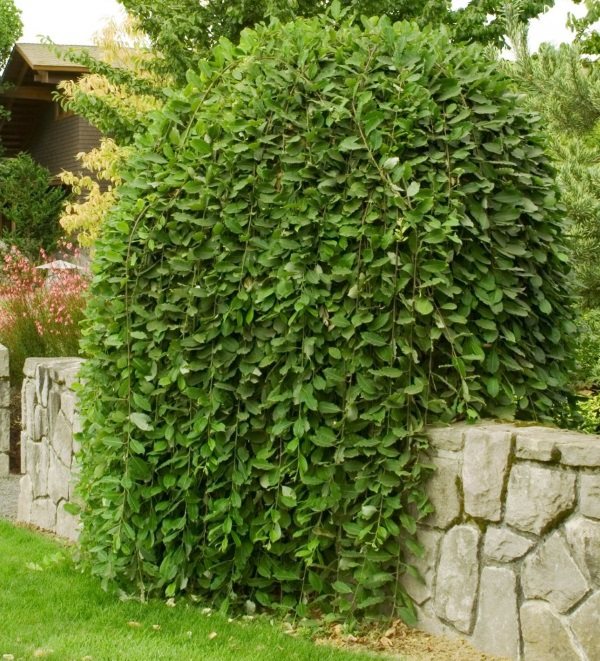

The plant loves light, however, it has shade-tolerant qualities. Favorite growing areas: fertile, rich, sandy or gravelly soils. At the same time, they should not be highly moistened - this can destroy the tree. As a conclusion - watering should be moderate. There is a bush along roads, houses, on the burrows of the forest, clearings. For planting, formed seedlings are used. If you need to propagate, then cuttings, seeds, or a method of grafting are suitable for this.
The characteristic features of the plant are:
- Branches... They are thick and spreading. In young individuals, they have a slightly grayish color and slight pubescence. In specimens that are grown up and well developed, the color of the branches can be greenish-gray or yellow-brown. If the tree is old, then its branches acquire a gray color, and besides, they become brittle.
- Bark. At first, it is green-gray in color and rather smooth. As it matures, the color changes to brown, and cracks form at the bottom of the trunk. As for the wood, it is smooth, but it turns red when it comes into contact with air.
- Foliage. It has an elliptical shape with a length / width of 11-18 / 5-8 cm, respectively. The outside is dark green and the underside is grayish. A distinctive feature is a jagged uneven edge. Buds are hidden in the axils of the leaves. They are quite large (length-width 5/3 cm, respectively). Flower buds are reddish in color and ovoid, not flattened, measuring 15 / 3-6 mm in length / width.
- Flowers, in the form of earrings. Goat willow bloom begins in April, before the foliage has begun to grow, and lasts 10-13 days. There are female and male flowers. The first are wide, oblong-oval in shape, up to 6 cm long. The second are dense, cylindrical in shape, reach 10 cm in length, multi-flowered.
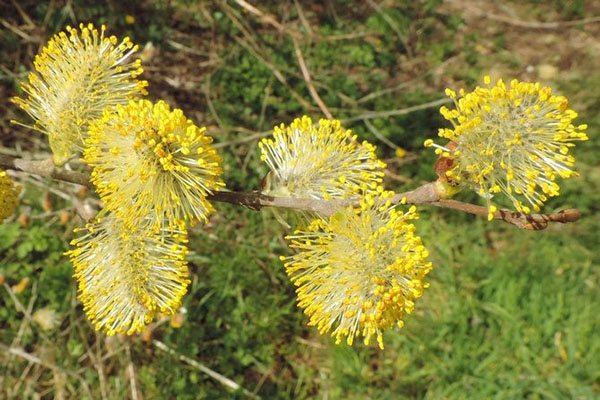

- Fetus. As a result of pollination in May, a fruit is formed in the form of a box with a diameter of about 7-8 cm, located on a fluffy petiole. Each fruit contains about 18 seeds with fluffy outgrowths, thanks to which the seeds are transferred over a distance. Unfortunately, seeds lose their germination very quickly.
Willow pear 'Pendula'
Willow pear, appearance. She's in bloom. Photo from the bluebellnursery website. Willow pear (Pyrus salicifolia 'Pendula') - a tree 5 m high and 4 m wide, with weeping branches and beautiful silvery leaves.
Caragana tree ‘Pendula’
A beautiful sculptural tree.
Caragana tree ‘Pendula’. Photo from baumschule-newgarden.de. She's in the mixborder. Photo from ecbrownsnursery.biz
Caragana arborescens 'Pendula' - a small tree 1.5 m high and 1.2 m wide. Picturesquely falling branches; especially beautiful during flowering.
Japanese Sophora 'Pendula'
One of the most beautiful forms of pendula for southern dachas.
Sophora Japanese 'Pendula', photo by author
Japanese Sophora (Sophora japonica ‘Pendula’) - a slow-growing tree 3 m high and 3 m wide with an umbrella crown, with green shoots hanging down to the ground.
Bird cherry fine ‘Kiku Shidare’
A small tree with weeping branches that form an irregular crown.
Bird cherry 'Kiku Shidare'. Photo from leafland.co.nz.
Bird cherry (Prunus 'Kiku Shidare') height and width 3 m; flowers are pink, double.
Mountain ash ‘Pendula’
A tree with an irregular crown, which is formed by twisted branches.
Mountain ash ‘Pendula, appearance’. Photo of the site Fruiting branches close-up. Photo by ilbosco website. Rowan (Sorbus aucuparia 'Pendula') - a tree, the height of which depends on the place of vaccination; especially effective in fruiting.
White mulberry 'Pendula'
A low, beautiful tree with a dense umbrella-shaped crown.
White mulberry 'Pendula', photo by the author
White mulberry (Morus alba 'Pendula') up to 3 m high and up to 5 m wide.
Weeping mulberries in an ordinary planting, photo by the author
Large heart-shaped leaves are beautiful; the fruits are edible.
Common ash 'Pendula'
An ancient weeping form with a beautiful hip-shaped crown.
Common Ash (Fraxinus excelsior 'Pendula') - height - 15 m, width - 8-10 m, with arched branches hanging down.
Beauty and form
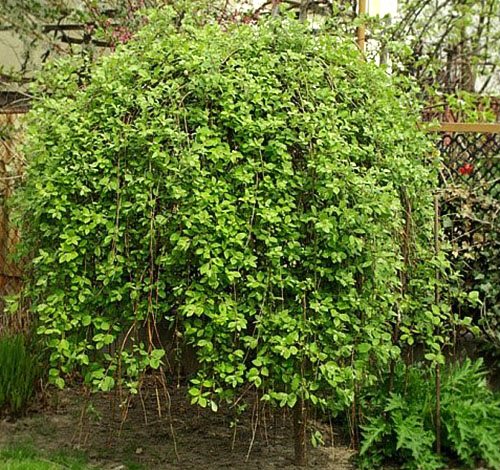

Goat willow is very common in landscape design. And all thanks to its beauty and shape. Moreover, the appearance of the plant is highly dependent on the soil in which it grows, and the illumination.
Most often, the rakita is planted in the improvement of private houses and estates. At first glance, the willow looks unprepossessing, but thanks to its weeping forms, grafted onto the stem, it acquires a very attractive appearance.
Willow looks great in rocky gardens, as well as on the edge of water bodies. It is worth appreciating another advantage of the plant - the ability to cement the soil with roots, so it is not surprising that it is often planted on slopes.
Varieties
Most often, gardeners pay attention to willow varieties such as "Silberglanz", which has a height of up to 8 m and a spreading crown, "Pendula", the main advantage of which is a weeping crown and a standard shape, and "Mas", which has a wide spreading crown and reaches a height of up to 10 m.
Goat willow Pendula
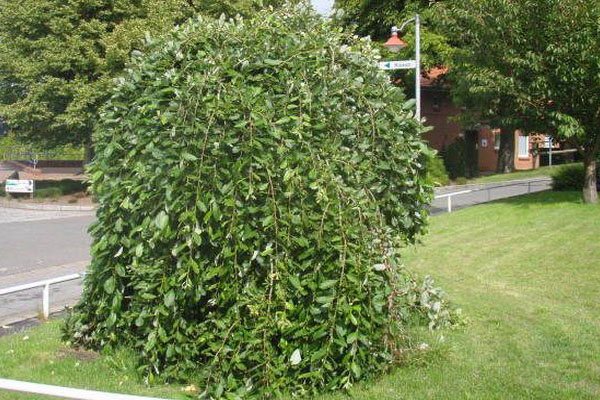

This is a deciduous tree, reaching a height and length of up to 2-3 m. As a rule, it lives no more than 30 years on soils of any moisture. A kind of shade-tolerant and photophilous. For normal growth, abundant watering is necessary. But in order to avoid overflow, a rather high drainage layer should be laid. The plant is frost-hardy, but it is recommended to cover the stem for the winter.
The dignity of the plant, we repeat, is a tent-shaped weeping crown. Goat willow looks great on a trunk. Of the many varieties, pendula can be identified by its dark green oblong-elliptical foliage up to 8-10 cm long. In autumn, the color turns yellow.
In April-May, flowering occurs (lasting 15 days) with the release of flat golden-yellow catkins. In the future, the fruit is formed in the form of a box.
In landscape design, pendula is planted both as a single tree and in decorative groups. Looks great in rock gardens and near water bodies. It goes well with dwarf coniferous trees, juveniles, moisture-loving plants and ground covers. As for reproduction, the procedure is performed by inoculation on a stem.
The most difficult thing to care for is pruning the Pendula goat willow. If the crown is not formed correctly during the first year, the branches will settle to the ground and the decorative value will be lost.


In young animals, all branches are pruned, leaving a length of only 15 cm. In this case, a bud should remain, looking to the side or up. But not inside the crown.With such a haircut, they achieve the formation of a shape similar to an open umbrella.
If the plant is adult, then pruning is carried out after flowering, shortening the branches by 2/3 of the entire length. This achieves dense branching of the crown.
Goat willow Kilmarnock
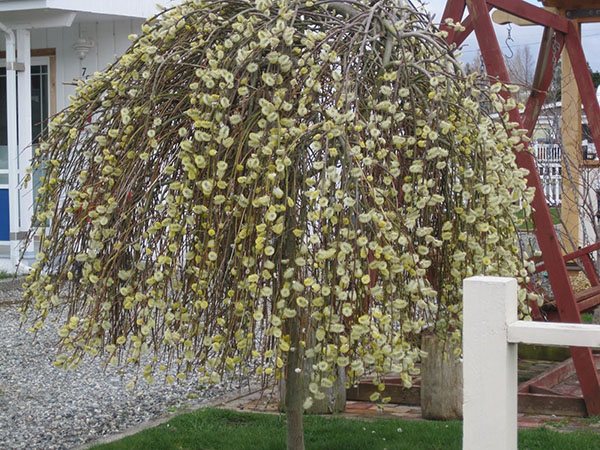

This variety is distinguished by its diminutiveness (maximum 1.5 m in height). The standard tree resembles an open umbrella with branches reaching the ground. The plant is frost and wind resistant, photophilous. It has no soil requirements, grows well on low-lime, loamy soils. The only drawback is sensitivity to moisture, so you need to be careful with watering.
You can identify the variety by foliage. It is green, oblong-elliptical, slightly wrinkled, yellowing in autumn.
In April, bloom begins with the release of numerous earrings with silvery and fragrant flowers.
Let's be treated!
If you decide to grow something in your garden that cannot be seen in everyone, then the goat willow Pendula is ideal for you. Diseases and pests are the only things that can darken the cultivation, but you can also fight ailments.
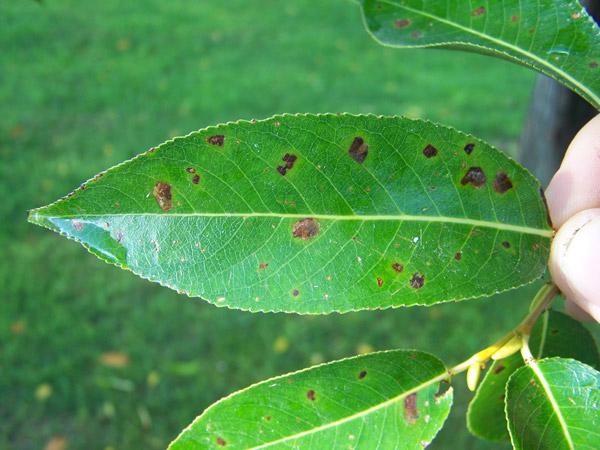

Consider what pests and diseases the willow is exposed to:
- Willow leaf roll. Harms the tree at the larval or caterpillar stage. To get rid of the insect, you can spray the willow with chemicals that are available in specialized stores.
- Flower fly. To begin with, it is worth finding a place where the larvae live. Remove the top layer of soil, if they are located there, then you will immediately find them. You can remove flies by watering the soil with a weak solution of potassium permanganate. If it does not help, then insecticides will come to the rescue.
- Powdery mildew. This is a representative of a fungal disease that multiplies at a high rate. Timely need to remove bad leaves. You can spray with a drug, the action of which is aimed at combating fungal diseases. It is recommended to replace some of the soil under the tree.
- Black spot. To avoid it, it is necessary to reduce the contact of leaves with water. It is sometimes difficult to do this outdoors, so choose places where the breeze will constantly blow the willow. Timely weeding of weeds and removal of debris under the tree helps to fight black spots.
Goat willow: planting and care


Planting is carried out with the onset of spring. Cuttings are placed in water in advance and wait for the roots to appear. After they should be transplanted into open ground, having previously dug a shallow hole. The extracted soil is mixed with compost, and after planting, the cuttings are poured into a hole and the soil is slightly crushed. After that, you should water the plant well with water. Subsequently, watering is performed 2-3 times / week. For adult specimens, regular watering is not required. If the weather is dry and hot in summer, the seedlings should be watered more often.


As for feeding, in the spring-autumn period it is carried out twice with complex means. In autumn, give preference to sulfuric potassium or superphosphate. In the presence of a large number of weeds around the tree, mulching is carried out with sawdust, peat, expanded clay, paper, crushed pebbles.
In case of rapid drying of the earth near the goat willow, loosening should be carried out, and if cracks have gone, then first the ground is watered and then loosened.
Do not forget about timely and regular cutting of trees.
Proper planting, watering control, and willow pruning will help you form a beautiful plant that will add grace to your home's landscaping.
Meet the goat willow - video
Plant care
Basic tree care includes:
- Watering. In the first year of life, this willow variety needs abundant moisture. A weeping beauty should consume about 50 liters of water in two weeks. If the summer is too dry, then this volume goes away in a shorter period.In the second, third and subsequent years, one irrigation is sufficient, which can be carried out every week.
- Fertilizer. For the entire period from early spring to autumn, you need to feed the willow two or three times. Complex mineral fertilizers are suitable for this. In September, the tree is fed with superphosphate or sulfuric potassium. If a dark bloom appears on the leaves, then copper oxychloride is used for treatment.
- Mulching. It helps to retain moisture and stop weeds from growing. Peat, paper, sawdust, expanded clay or pebbles are ideal for this. All this material is crushed and scattered under the tree on top of the soil.
- Loosening. If the ground under the plant is too dry and cracks have formed, they must be removed. To do this, loosen the soil a day after watering.
- Preparing for winter. This step in care is also significant. In order for the plant to endure our harsh winter well, the trunk is wrapped in a covering material. This procedure is used for trees under three years old.
We looked at how to properly care for a plant such as Pendula goat willow. Pruning is another main type of maintenance that we will pay special attention to.

